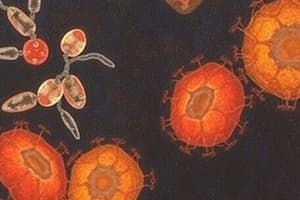Podcast
Questions and Answers
Explain the significance of the variable region in B-cell receptors (BCRs) and how it relates to the recognition of diverse antigens.
Explain the significance of the variable region in B-cell receptors (BCRs) and how it relates to the recognition of diverse antigens.
The variable region of BCRs is crucial for antigen recognition because it contains the antigen-binding site. This region exhibits high variability due to the unique arrangement of amino acids, allowing each B-cell to bind to a specific antigen. This diversity in BCR variable regions ensures that the immune system can effectively recognize and respond to a vast array of antigens, including carbohydrates, lipids, DNA, and proteins.
Describe the key difference between the antigen recognition mechanisms of B-cell receptors (BCRs) and T-cell receptors (TCRs).
Describe the key difference between the antigen recognition mechanisms of B-cell receptors (BCRs) and T-cell receptors (TCRs).
BCRs directly recognize and bind to intact antigens, while TCRs only recognize peptide antigens presented by Major Histocompatibility Complex (MHC) molecules on the surface of antigen-presenting cells (APCs). This means that B cells can respond to a wider range of antigens, while T cells are specifically activated by antigens presented in a complex with MHC proteins.
Explain the process of clonal selection in B-cell activation, emphasizing the role of antigen binding.
Explain the process of clonal selection in B-cell activation, emphasizing the role of antigen binding.
Clonal selection begins when an antigen binds to the BCR of a specific naive B cell. This binding event activates the B cell, causing it to proliferate rapidly and produce clones. Each clone expresses the same BCR as the original activated B cell, ensuring that the immune response is tailored to the specific antigen. This clonal expansion allows the immune system to generate a large population of antigen-specific B cells, amplifying the response.
Discuss the importance of memory B cells in providing long-lasting immunity.
Discuss the importance of memory B cells in providing long-lasting immunity.
Explain how vaccines work in the context of B-cell activation and antibody production.
Explain how vaccines work in the context of B-cell activation and antibody production.
Explain the process of generating antibody diversity through combinatorial diversity. Describe the specific gene segments involved, and the role of genetic recombination in this process.
Explain the process of generating antibody diversity through combinatorial diversity. Describe the specific gene segments involved, and the role of genetic recombination in this process.
Describe the role of dendritic cells in initiating the adaptive immune response. Explain how they acquire and present antigens to lymphocytes, highlighting the importance of their location and migration.
Describe the role of dendritic cells in initiating the adaptive immune response. Explain how they acquire and present antigens to lymphocytes, highlighting the importance of their location and migration.
Discuss the concept of 'memory' in the adaptive immune response. Describe the cells involved and their role in providing long-term protection against specific pathogens.
Discuss the concept of 'memory' in the adaptive immune response. Describe the cells involved and their role in providing long-term protection against specific pathogens.
Explain the difference between humoral and cell-mediated immune responses, highlighting the key components involved and their respective roles in fighting infection.
Explain the difference between humoral and cell-mediated immune responses, highlighting the key components involved and their respective roles in fighting infection.
Describe the process of somatic hypermutation in B cells. Explain its role in enhancing antibody affinity and the significance of this process for the adaptive immune response.
Describe the process of somatic hypermutation in B cells. Explain its role in enhancing antibody affinity and the significance of this process for the adaptive immune response.
Explain the role of the lymphatic system in the adaptive immune response. Describe how antigens reach lymph nodes and how this contributes to the activation of lymphocytes.
Explain the role of the lymphatic system in the adaptive immune response. Describe how antigens reach lymph nodes and how this contributes to the activation of lymphocytes.
Describe the role of immunoglobulin D (IgD) in B cell activation. Explain its function as a B cell receptor and how it differs from secreted antibodies.
Describe the role of immunoglobulin D (IgD) in B cell activation. Explain its function as a B cell receptor and how it differs from secreted antibodies.
Explain the concept of 'clonal selection' as it relates to the adaptive immune response. How does this process contribute to the generation of specific antibody responses against pathogens?
Explain the concept of 'clonal selection' as it relates to the adaptive immune response. How does this process contribute to the generation of specific antibody responses against pathogens?
Flashcards
B-cells
B-cells
Lymphocytes that produce and secrete antibodies for humoral immunity.
T-cells
T-cells
Lymphocytes that kill infected cells and mediate cellular immunity.
B-cell receptor (BCR)
B-cell receptor (BCR)
Membrane-bound antibodies that bind to specific antigens, aiding activation of B-cells.
Clonal selection
Clonal selection
Signup and view all the flashcards
Memory B-cells
Memory B-cells
Signup and view all the flashcards
Antibody diversity
Antibody diversity
Signup and view all the flashcards
Variable region
Variable region
Signup and view all the flashcards
Dendritic cells
Dendritic cells
Signup and view all the flashcards
Adaptive immunity
Adaptive immunity
Signup and view all the flashcards
Humoral response
Humoral response
Signup and view all the flashcards
Somatic hypermutation
Somatic hypermutation
Signup and view all the flashcards
Pathogen recognition receptors (PRR)
Pathogen recognition receptors (PRR)
Signup and view all the flashcards
Study Notes
Antibody Production and Adaptive Immunity
- Antibodies are produced by B cells, which originate in the bone marrow.
- Each B-cell clone produces a unique antibody.
- Immunoglobulin D (IgD) acts as the B-cell receptor.
- Antibodies have a variable region (different for each antibody) and a constant region (same for a class of antibodies).
- The adaptive immune system is not inherited; it's generated anew.
Antibody Gene Structure and Diversity
- Antibody genes are found in segments on chromosomes.
- Segments include variable (V), diversity (D), and joining (J) gene segments (more V and J segments for light chains).
- Heavy chains have D segments and light chains don't.
- The number of variable gene segments is approximately 30-45.
- B cells create unique antibodies by recombining these gene segments.
- Combinatorial Diversity: V, D, J gene segment combinations create diversity.
- Junctional Diversity: Random mutations at the junctions of gene segments add more diversity.
- Somatic Hypermutations: Further mutations occur in the variable region after antigen binding, increasing antibody affinity.
B-Cell Activation and Antibody Secretion
- When a B cell binds to an antigen, it proliferates rapidly, creating a clone of identical B cells.
- Activated B cells differentiate into plasma cells and memory B cells.
- Plasma cells produce large amounts of antibodies, while memory B cells provide long-term immunity.
- Antibodies are secreted in the blood as part of the humoral immune response.
- This process takes approximately 5-6 days after infection.
Adaptive Immune Response and Memory
- The adaptive immune system has memory, allowing it to respond quicker and stronger upon re-exposure to a pathogen. This is a key aspect of vaccination.
- Humoral immunity involves antibodies, while cell-mediated immunity involves other cells.
- Memory is controlled by B and T cells.
Antigen Presentation and the Lymphatic System
- Dendritic cells (DCs) are antigen-presenting cells found in epithelial tissues.
- They have long cytoplasmic projections (dendrites) to capture antigens.
- DCs recognize pathogens using pathogen recognition receptors (PRRs).
- When exposed to microbes and cytokines, DCs activate and migrate to lymph nodes to present antigens.
- Lymph fluid circulates the body, driven by muscle movement, carrying antigens to lymph nodes.
- Lymph nodes are crucial for antigen presentation to B and T cells.
- Macrophages also present antigens in the lymph nodes, and soluble antigens from the bloodstream reach the spleen.
B Cells and T Cells: Lymphocytes
- B cells produce and secrete antibodies, mediating humoral immunity.
- B cells mature in the bone marrow.
- T cells directly kill infected cells, mediating cell-mediated immunity.
- T cells mature in the thymus.
- Both B and T cells originate from stem cells in the bone marrow.
B Cell Receptor (BCR) and T Cell Receptor (TCR)
- BCRs are membrane-bound antibodies (IgD); they have two heavy and two light chains, forming two antigen-binding sites.
- BCRs recognize various antigens (carbohydrates, lipids, DNA, proteins).
- TCRs are similar to antibodies but have one antigen-binding site, recognizing antigens presented by infected cells.
- TCRs have an α (alpha) chain and a β (beta) chain, connected by disulfide bridges.
- Both BCR and TCR structures are generated using similar gene-segment rearrangements.
B Cell Activation, Clonal Selection, and Antibodies
- B cells are activated when their BCRs bind antigens in lymph nodes.
- Activated B cells undergo rapid proliferation to create clones.
- Clones differentiate into plasma cells (immediate antibody producers) and memory B cells.
- Plasma cells produce large amounts of antibodies.
- Memory B cells provide rapid and greater response to future encounters with the same antigen.
- Vaccines trigger antibody production and memory cell formation, providing future immunity.
Studying That Suits You
Use AI to generate personalized quizzes and flashcards to suit your learning preferences.
![Lecture 05: Antibody Production and Adaptive Immunity [SEQ 1]](https://images.unsplash.com/photo-1486475554424-2fa50cd59f18?crop=entropy&cs=srgb&fm=jpg&ixid=M3w0MjA4MDF8MHwxfHNlYXJjaHw1fHxhbnRpYm9keSUyMHByb2R1Y3Rpb24lMkMlMjBhZGFwdGl2ZSUyMGltbXVuaXR5JTJDJTIwaW1tdW5lJTIwc3lzdGVtfGVufDF8MHx8fDE3Mzg3MzIzNTh8MA&ixlib=rb-4.0.3&q=85&w=800&fit=crop&h=300&q=75&fm=webp)



![Lecture 05: Antibody Production and Adaptive Immunity [SEQ 2]](https://assets.quizgecko.com/cdn-cgi/image/width=300,height=200,fit=crop,quality=75,format=webp/quiz/f58dc4dbf6c4223e9570af009a23110d.jpg)